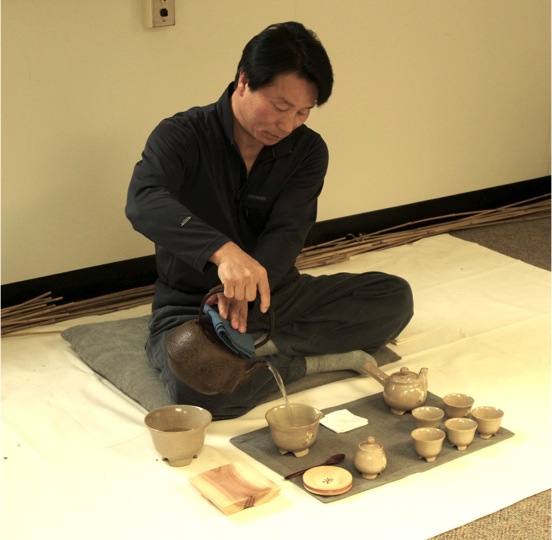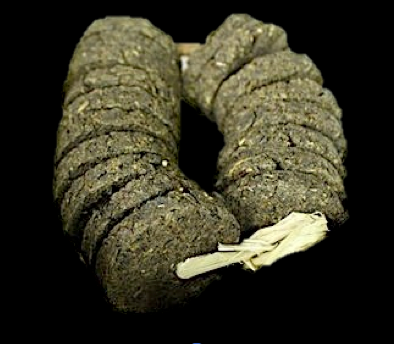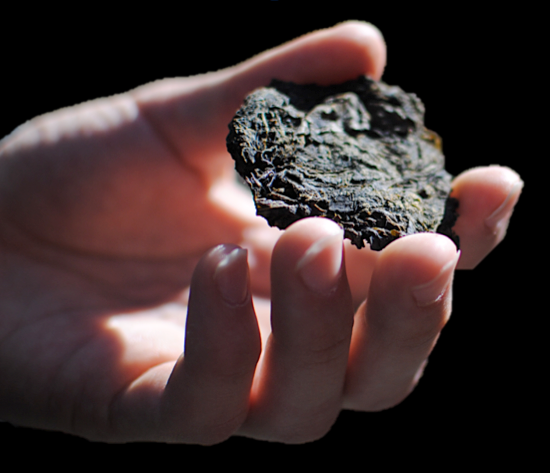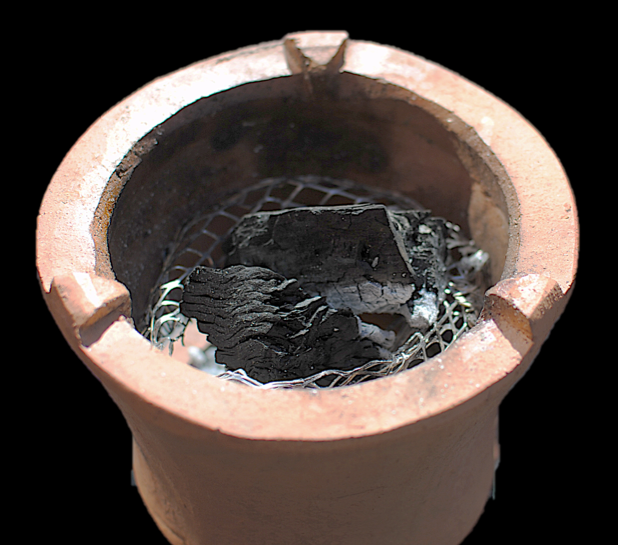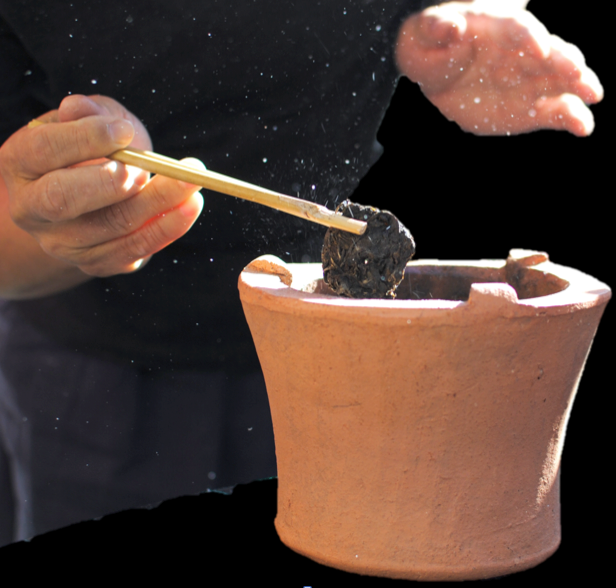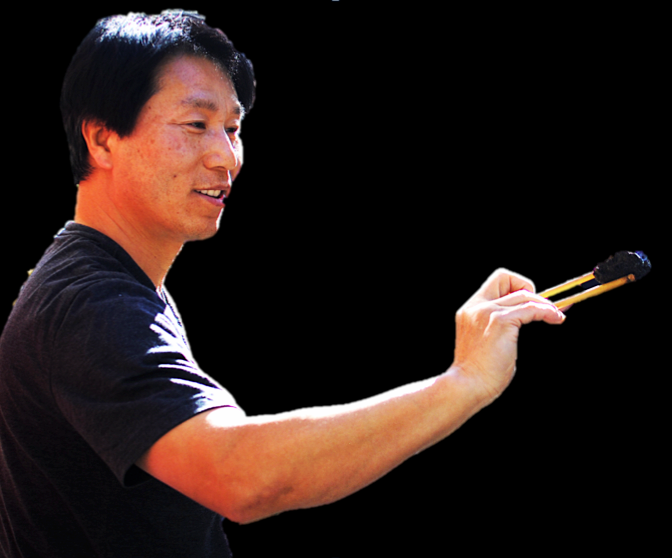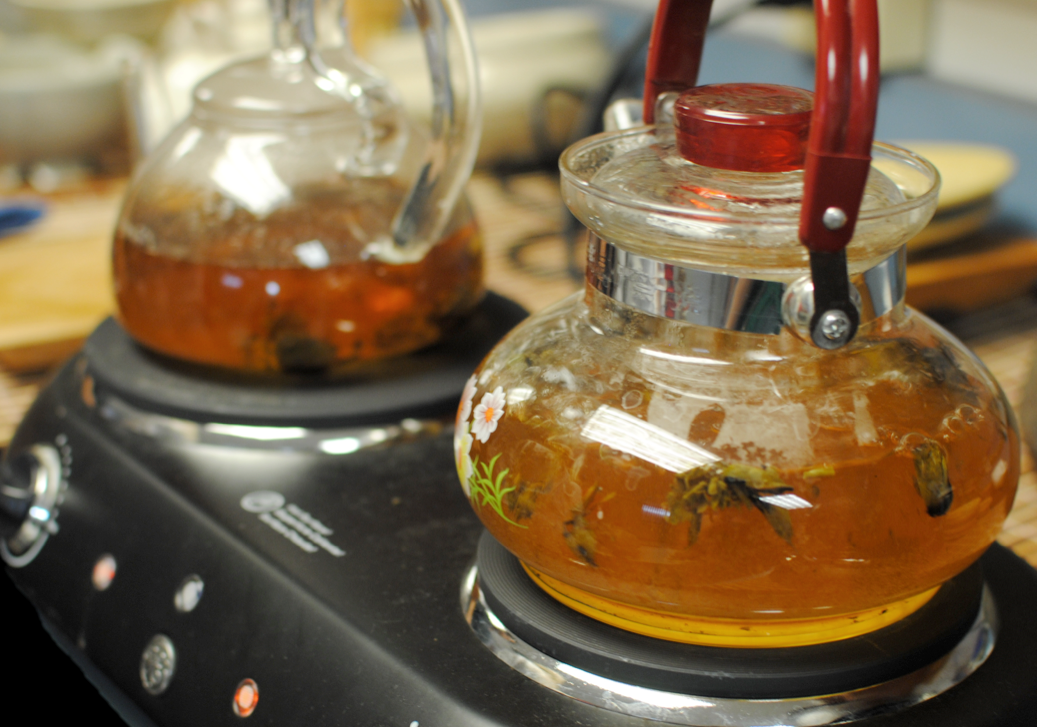Report on the 2012 Korean Tea Exhibition: Tteok-cha
Caked tea was among the many decoctions offered during the Korean Tea Exhibition held in early April at The Tea Institute of Pennsylvania State University. Renowned in Korea as tteok-cha, caked tea was served at the Penn State Tea House to Institute members, participants, and guests. The event was unscheduled, and all were pleasantly surprised when told of the extraordinary chance to experience such an unusual kind of tea.
Hong Kyeong-Hee prepared the caked tea before a curious and expectant audience. Known by his tea name Master Hyo-am, Mr. Hong teaches tea at Inje University and the Panyaro Institute for the Way of Tea. During the Exhibition, he performed steeped and whisked tea ceremonies as well as taught master classes to members of the Institute. For several years now, Master Hyo-am has lived on Mount Jiri, South Jeolla province, preserving the tradition of making, preparing, and serving tea. Anticipating his visit to the Institute, he packed and brought with him a number of tea cakes, tteok-cha that he had made in May 2011 from leaves of wild tea grown on the mountain slopes near his home.
Tteok-cha 떡차 is an ancient form of tea, the leaves usually steamed, pounded, and compressed into a small cake. Caked tea was first recorded in China as bingcha 餅茶 during the Three Kingdoms period, circa third century A.D. Then as now, the making of caked tea was time consuming, labor intensive, and expensive. Given its cost and rarity, tteok-cha was prepared and served with regard and ceremony as part of high etiquette, and the drinking of the brew was considered special. In Korea, caked tea was once called byeong-cha 병차 and was likely introduced during the Samguk era before 500 A.D. as a precious import to the peninsula from the continent.
Long ago, tteok-cha was named after the food known as tteok 떡, the Korean rice cake made in the tenth lunar month from newly harvested grain. Rice cake is made from very fine rice flour mixed with pure water. The white dough is steamed and then pounded and rolled to make a thick rope of dense paste. Allowed to dry slightly, the roll is cut into small rounds and used in cooking. Put in broth, stir-fries, sauces, seasonings, and other traditional dishes, cooked tteok is a soft, chewy pasta especially celebrated as a customary food during holidays and festivals.
The many parallels between caked tea and rice cake are striking. Caked tea is not only similar to the making of rice cake but it is also alike in shape, the pieces resembling flat, thick disks the size of a large coin. Indeed, during the Joseon dynasty, tteok-cha was also known as jeon-cha 전차 or jeon-da 전다, “coin” tea. And like the various forms of rice cake made for special occasions, caked tea comes in many different shapes, including rounds, squares, rectangles, pentagonals, hexagonals, octagonals, flowers, and even buns and cones.
Master Hyo-am produced a tteok-cha that was formed by hand into a thick wafer of roughly circular shape. Although compressed, the texture of the leaves in the wafer was discernable. The caked tea was dark in tone and richly mottled in varying shades of brown, green, blue, and gray. Leading everyone from the Institute Tea House to an outdoor patio, Master Hyo-am lit a charcoal fire in a ceramic brazier to prepare for the heating and browning of the caked tea.
The fuel provided by the Institute for the occasion is called longyan charcoal, an amorphous form of carbon produced by burning in the absence of air the wood of the longyan tree.
The longyan 龍眼 (Dimocarpus longan) is a fruit bearing tree, the trunk of which produces a dense grained, slow burning charcoal that is nearly smokeless and sweetly aromatic. Today longyan charcoal is famously used in the drying of some oolong teas (wulong cha 烏龍茶) in Taiwan and Fujian, although the fuel is actually made from the comparable but more plentiful wood of the lychee 荔枝 (Litchi chinensis). When the charcoal was hot, Master Hyo-am grasped the tteok-cha with bamboo tongs and began to toast the wafer of tea.
Since ancient times, tteok-cha was toasted before brewing, using tongs of bamboo. The use of bamboo tongs to brown caked tea was recommended in the Book of Tea written in 780 A.D. by the tea master Lu Yü: “Use young, green bamboo…to toast the caked tea…In the heat of the fire, the small cane of this bamboo is moist, bestowing its fragrance and purity and enhancing the flavor of tea.” Skillfully using his tongs, Master Hyo-am gingerly placed the wafer directly on the glowing coals.
Lu Yü described holding the cake “near the fire” and “waiting for it to toast and produce on its surface little banks and mounds resembling the back of a toad.” Withdrawn from the fire, the cake was toasted again until “the pulp becomes soft and pliable…” Heating the cake drove off excess moisture and further dried the tea, making it brittle when cooled. Exposure to heat also produced the Maillard reaction or browning, a chemical reaction between amino acids and sugars that determined flavor, aroma, and color.
When the tteok-cha was toasted, Master Hyo-am returned to the Tea House where he divided the tea, placing the parts in two glass kettles of boiled water to simmer and brew. As the tea boiled, the dark honey color of the liquor deepened to a rich amber hue.
In the bowl, the tea was fragrant and tasted remarkably sweet with no hint of harshness or medicinal character. Its flavor was described as “fruity” and “mostly spice and a slight woodiness.” The long, lingering taste of the brew was once explained and portrayed by Lu Yü in the Book of Tea as “wonderfully beautiful and lasting” and a “flavor that endures.”
After drinking two bowls, the tteok-cha produced a remarkable feeling of lightness and elevation. When told of the sensation, Master Hyo-am just nodded and smiled.
Many thanks to Brother Anthony of Taizé, Jason M. Cohen, Executive Director of The Tea Institute of Penn State, and Eric Glass of The Fragrant Cup for their comments on the flavor of Master Hyo-am’s tteok-cha. Cohen also identified the charcoal and cited the Maillard reaction as a factor in the taste of the tea. Thanks also to Gabrielle Parker, Director of Marketing, for her photographs of Master Hyo-am and his caked tea.

